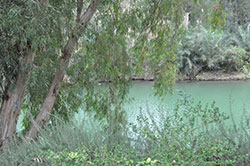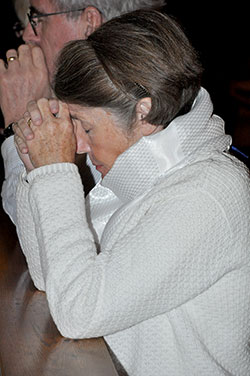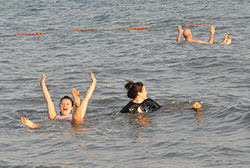By Natalie Hoefer
CAPARNAUM, RIVER JORDAN, JERICHO and BETHANY—Christ began his ministry in the town of Capernaum on the Sea of Galilee and finished in Jerusalem. The pilgrims did the same today, starting in Capernaum on the north shore of the Sea of Galilee at the site of Peter’s home and ending the day at their hotel in Jerusalem after Mass in Bethany.
In Capernaum, the pilgrims visited the remains the home of Peter and the synagogue where Jesus preached, as recounted in chapter four of the Gospel of Luke. (See a photo gallery from their day)
Tony Azraq, the Palestinian Catholic archaeologist serving as the pilgrimage tour guide, explained that the authenticity of the sites can be confirmed by archaeological remains proving the structures to be locations of early Christian pilgrimages.
Archbishop Joseph W. Tobin found the site over the synagogue where Jesus preached to be meaningful.
“I think the visit to the synagogue at Capernaum was important for me because of Jesus’ famous sermon there in Luke [chapter] four, which is also what St. Alphonsus cited as the reason for starting the Redemptorists,” said Archbishop Tobin, who belongs to the Redemptorist order. The archbishop explained that St. Alphonsus stated in the introduction to the Redemptorist rule: “We propose to follow in the steps of Christ the Redeemer, who said of himself, ‘The spirit of the Lord is upon me, and he has anointed me to bring good tidings to the poor.’ ”
The pilgrims then traveled by bus along the Jordan River in which Christ was baptized. Along the edge of the river, Archbishop Tobin led a service in which the pilgrims renewed their baptismal vows.
Pat Maher, a member of SS. Peter and Paul Cathedral in Indianapolis, was moved by the service, especially since he turned 60 today.
“What a great blessing it was to be able to renew my baptismal vows on my birthday,” he said. “I asked God before the trip to give me a present for my birthday. And he never fails. He’s way more generous than we can ever anticipate.”
The pilgrims’ next stop was in Jericho, which lies below what is known as the Mount of Temptation. Jesus fasted for 40 days on this desert mountain.
According to Azraq, springs existed in Jericho in the time of Christ, making the land fertile and plentiful.
“You hear Jesus went to the desert and you think there isn’t much there to tempt him,” he explained. “If you’re locked in a room with no food, there is nothing to tempt you. But he came to this desert mountain with all that he could not have lying right below him in full view, like locking yourself in a room full of everything you like to eat while trying to fast. He chose the hard temptation.”
Before heading to Bethany for Mass, the pilgrims stopped at the Dead Sea to wade or swim in its salt- and mineral-laden waters.
“I was just amazed at the bravery of my fellow pilgrims who went into the Dead Sea,” the archbishop said. “Especially Rita, who has had 86 springtimes!”
The Mass took place in Bethany outside of Jerusalem at St. Lazarus Church, believed to be built over the site of what had been the home of Lazarus, Martha and Mary.
In his homily, Archbishop Tobin reflected on his thoughts while visiting the site of the home of St. Peter in Capernaum. He recalled the “four friends who brought their paralyzed buddy [to be healed by Jesus. But they can’t get in. So they took one of those [roof] tiles away and lowered their friend down to be near Jesus.
“I thought, ‘Isn’t that an image of us?’ … I think we have to be able to remove the tiles, the things that keep people from coming to Jesus. Either the wrong ideas or sweating the small stuff. We want them to hear the Lord.”
Archbishop Tobin then addressed the question, “Why is the Dead Sea so dead?”
“It’s because all that nice water we saw in the Sea of Galilee comes down the Jordan through the plains of Samaria and Judea—and then it doesn’t go anywhere,” he said. “It just stagnates, and that’s why it’s so dead.
“Let’s pray that the Lord will help us to know where we need to remove the tiles so that others may come to know what we know.”
See a photo gallery from Day Six of the pilgrimage



No comments:
Post a Comment